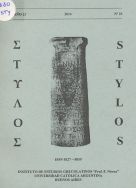Cómo hacer conjuros con palabras: lineamientos para un análi-sis performativo del discurso mágico-ritual en Séneca, Medea, 1-55
Palabras clave:
Medea, Conjuro, Enunciados realizativos, IntratextualidadResumen
En el presente trabajo abordaremos el conjuro inicial de Medea en la tragedia epónima de Séneca a la luz del primer desarrollo teórico de Austin, compendiado junto con el subsiguiente en las conferencias publicadas bajo el título Cómo hacer cosas con palabras. El filósofo del sentido común, abordando situaciones altamente ritualizadas, admite la división entre enunciados realizativos y constativos. A partir del análisis de las condiciones que presenta Austin para los enunciados realizativos intentaremos
demostrar que Medea, en su conjuro inicial, con palabras hace. La eficacia del conjuro permite un análisis intratextual de la obra en el que el primer parlamento de la hechicera puede entenderse como motorizador del ir y venir de los restantes personajes de la obra.
Descargas
Citas
EDICIONES LATINAS CON APARATO CRÍTICO Y TRADUCCIONES AL ESPAÑOL
CHAUMARTIN F.R.; Sénèque, Tragedies, Tome I. Paris, Les Belles Lettres, 2000; t.II.
ELLIOTT, A.; Euripides Medea, edited by Elliot, Great Britain, Oxford University Press, 1979.
HERRMANN, L.; Séneque Tragédies, Paris, Les Belles Lettres, 1924, t. I.
LEO, F.; Senecae Tragoediae, Berolini, Apud Weidmannos MCMLXIII.
ZWIERLEIN, O.; Kritischer Kommentar zu den Tragödien Senecas, Stuttgart, 1986.
BIBLIOGRAFIA CONSULTADA
ARCELLASCHI, A.; Médée dans le Théâtre latin d’Ennius à Sénèque, Rome, Ecole Française de Rome, 1990.
AUDRAIN, C.;“La Médée de Sénèque: de la virgo nefas à Medea” en SATTI, N. (ed.) Réécritures de Médée, Centre de Recherches en études Féminines et études de genre , Université Paris 8, Université Paris 8, Vincennes-Saint-Denis, 2007.
CABALLERO DEL SASTRE E.; “El furor de Medea en Ovidio (Met. 7.1-42) y en la tragedia de Séneca”, en STEINBERG, M.E. y CABALLERO, P. (eds), Philologiae Flores, Buenos Aires, UBA, 2010.
DANGEL, J.; Monodie et choeurs dans la Médée de Sénèque. In: Vita Latina, N°162, 2001, pp. 11-21.
GARELLI, F.M.H.; Sénèque et le temps dramatique. In: Vita Latina, N°147, 1997, pp. 20-29.
GRAF, F.; “Medea, the enchantress from afar. Remakes on a well-known myth”. In: CLAUSS, J. J. JOHNSTON, S. I. (edd.); Essays on Medea in myth, literature, philosophy and art, Princeton University Press, pp. 22-42.
HERRMAN, J. G.; “Les tragédies de Sénèque étaient-elles destinées au théâtre?” .Dans: Revue belge de Philologie et d´histoire, 1924, vol. 3, pp. 841-846.
HIDALGO DE LA V., M.J., ET CHAULET, R.; “Voix soumises, practiques transgressives. Les magiciennes dans le roman gréco-romain”. In: Dialogues d'histoire ancienne , vol. 34 N°1, 2008. pp. 27-43.
TUPET, A.M.; La magie dans la poésie latine, Paris, Les Belles Lettres, 1976.
PICONE, G.; “La Medea de Seneca come fabula dell’ inversione”, en LÓPEZ, A. – POCIÑA, A. (eds.); Medeas. Versiones de un mito desde Grecia hasta hoy, Universidad de Granada, 2002, vol. I, pp. 487-533.
NUSSBAUM, M.; “Serpents in the soul. A Reading of Seneca’s Medea”, in CLAUSS, J. J, 1997.
VERNANT, El universo, los dioses, los hombres, Barcelona, Ed. Anagrama, 1999.
VIZZOTI, M.M; “Séneca, didascalias y voluntad de representación”. En Auster, n°12, 2007, UNLP.
Descargas
Publicado
Cómo citar
Número
Sección
Licencia






